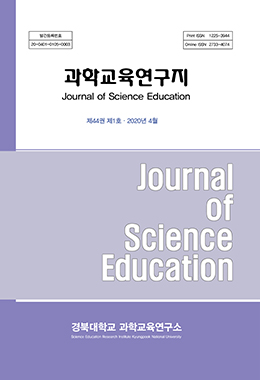컴퓨팅 사고(computational thinking)는 2015 개정 과학교육과정 및 미국의 차세대 과학교육표준(NGSS)에서 새로운 탐구 기능 혹은 역량으로 제시되고 있다. 특히, 2014년부터 교육부가 소프트웨어 교육을 필수화함에 따라 컴퓨팅 사고에 관한 관심은 더욱 커지고 있다. 그러나 과학교육 분야에서 컴퓨팅 사고를 어떻게 접목할 것인가에 대한 논의는 아직 부족한 실정이다. 이에, 본 연구에서는 다양한 관련 분야의 문헌 분석을 통해 컴퓨팅 사고 요소들을 과학 탐구에 접목하는 방안을 마련하고자 하였다. 이를 위해 먼저 컴퓨팅 사고의 요소에 대한 여러 정의를 정리하였고, 이를 활용한 모형을 개발하기 위해 일반 문제해결 과정과 과학적 탐구과정들을 종합적으로 분석하였다. 마지막으로 컴퓨터 과학 분야에서 문제해결에 접목한 사례들과 비교하여 컴퓨팅 사고 기반 과학 탐구(CT-SI) 모형의 요소들을 정리하였다. 정리된 요소들을 이학 전문가들에게 제공하여 각 분야의 연구 과정과 컴퓨팅 사고 요소들을 접목하여 설명하게 한 후, 이를 기반으로 문제발견형 CT-SI 모형과 문제해결형 CT-SI 모형을 개발하였다. 개발된 두 모형은 이학 전문가들에 의해 모형의 단계가 각 분야의 연구에 활용 가능하다고 검토받았으며, ‘문제발견형’은 과학 연구 과정에서 정보를 선별하고 문제를 분석하는 과정과 이론적 연구에서 근거를 기반으로 하는 추론 연구 과정에 적합하다고 응답하였다. ‘문제해결형’은 과학의 일반적인 연구 과정 및 공학설계를 활용한 공학적 문제해결과정에 적합하다고 응답하였다. 또한, 현장 교사 2인에 의해 중고등학교 현장 탐구 수업에 적용 가능함을 확인하였다. 본 연구에서 개발된 모형은 다양한 과학 교과의 탐구 활동과 연계할 수 있으며 이를 통해 2015 개정 교육과정에서 제시하고 있는 ‘자료의 수집, 분석 및 해석’, ‘ 수학적 사고와 컴퓨터 활용’ 역량을 길러줄 수 있을 것이다.
The 2015 revised science curriculum and NGSS (Next Generation Science Standard) suggest computational thinking as an inquiry skill or competency. Particularly, concern in computational thinking has increased since the Ministry of Education has required software education since 2014. However, there is still insufficient discussion on how to integrate computational thinking in science education. Therefore, this study aims to prepare a way to integrate computational thinking elements into scientific inquiry by analyzing the related literature. In order to achieve this goal, we summarized various definitions of the elements of computational thinking and analyzed general problem solving process and scientific inquiry process to develop and suggest the model. We also considered integrated problem solving cases from the computer science field and summarized the elements of the Computational Thinking-Scientific Inquiry (CT-SI) model. We asked scientists to explain their research process based on the elements. Based on these explanations from the scientists, we developed ‘Problem-finding’ CT-SI model and ‘Problem solving’ CT-SI model. These two models were reviewed by scientists. ‘Problem-finding’ model is relevant for selecting information and analyzing problems in the theoretical research. 'Problem solving' is suitable for engineering problem solving process using a general research process and engineering design. In addition, two teachers evaluated whether these models could be used in the secondary school curriculum. The models we developed in this study linked with the scientific inquiry and this will help enhance the practices of ‘collecting, analyzing and interpreting data,’ ‘use of mathematical thinking and computer’ suggested in the 2015 revised curriculum.




